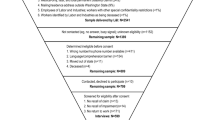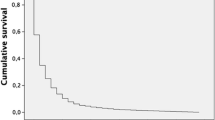Abstract
Aim After work-related injury or disease, multiple spells of work absences and unsuccessful return to work (RTW) are common. The purpose of this study was to identify predictors of sustained RTW and work disability recurrences. Methods Australian WorkSafe Victoria claims containing income compensation payments starting between January 1st, 2001 and December 31st, 2004 (n = 59,526) were analysed over a 2-year observation window. Time until first RTW and final RTW, and ‘recurrences’ (cessations of payments of >7 days), were derived from claims payments data. Regression models were used relating demographic, occupational, workplace and injury characteristics to RTW outcomes. Results Although 94% of claimants had at least one RTW, only 79% achieved sustained RTW during follow-up. Median time until first RTW was 50 days; median time until final RTW was 91 days. Independent predictors of delayed final RTW were older age, afflictions involving the neck or multiple locations, and working in manufacturing. Of those who returned to work, 37% had at least one recurrence: risk factors were ages 35–55, female sex, working as a labourer, working in manufacturing, traumatic joint/ligament or muscle/tendon injury and musculoskeletal and connective tissue diseases, and afflictions involving the neck or multiple locations. Conclusions Work disability recurrences are common and have considerable impact on sustained RTW outcomes. A policy focus on education about secondary prevention may help improve long-term RTW outcomes, particularly for persons with musculoskeletal disorders and those working in manufacturing.



Similar content being viewed by others
References
Australian Bureau of Statistics. Work-related injuries 2007.
Krause N, Dasinger LK, Deegan LJ, Brand RJ, Rudolph L. Alternative approaches for measuring duration of work disability after low back injury based on administrative workers’ compensation data. Am J Ind Med. 1999;35(6):604–18.
Amick BC, III, Lerner D, Rogers WH, Rooney T, Katz JN. A review of health-related work outcome measures and their uses, and recommended measures. Spine (Phila Pa 1976). 2000;25(24):3152–60.
Butler RJ, Johnson WG, Baldwin ML. Managing work disability—why 1st return to work is not a measure of success. Ind Labor Relat Rev. 1995;48(3):452–69.
Oleinick A, Gluck JV, Guire K. Factors affecting first return to work following a compensable occupational back injury. Am J Ind Med. 1996;30(5):540–55.
Australian Bureau of Statistics and Statistics New Zealand. Australian and New Zealand standard classification of occupations (ANZSCO). 1st ed. 2006. Available from: http://www.abs.gov.au/ausstats/abs@nsf/mf/1220.0
Australian Bureau of Statistics and Statistics New Zealand. Australian and New Zealand standard industrial classification (ANZSIC). 2006 [16 June 2011]. Available from: http://www.ausstats.abs.gov.au/Ausstats/subscriber.nsf/0/19C21C5659BCAE73CA2574C8001474E4/$File/12920_2006%20(revision%201).pdf.
Australian Safety and Compensation Council. Type of occurrence classification system 3rd ed. Revision 1. Canberra2008 [16 June 2011]. Available from: http://www.safeworkaustralia.gov.au/AboutSafeWorkAustralia/WhatWeDo/Publications/Documents/207/TypeOfOccurrenceClassificationSystem(TOOCS)3rdEditionRevision1.pdf.
SAS software, Version 9.2. Copyright (c) 2002–2008 by SAS Institute Inc., Cary, NC, USA.
Ruseckaite R, Collie A. Repeat workers’ compensation claims: risk factors, costs and work disability. BMC Public Health. 2011;11:492.
Baldwin ML, Johnson WG, Butler RJ. The error of using returns-to-work to measure the outcomes of health care. Am J Ind Med. 1996;29(6):632–41.
Cifuentes M, Willetts J, Wasiak R. Health maintenance care in work-related low back pain and its association with disability recurrence. J Occup Environ Med. 2011;53(4):396–404.
Wasiak R, Verma S, Pransky G, Webster B. Risk factors for recurrent episodes of care and work disability: case of low back pain. J Occup Environ Med. 2004;46(1):68–76.
Gross DP, Battie MC. Functional capacity evaluation performance does not predict sustained return to work in claimants with chronic back pain. J Occup Rehabil. 2005;15(3):285–94.
Young AE, Roessler RT, Wasiak R, McPherson KM, van Poppel MNM, Anema JR. A developmental conceptualization of return to work. J Occup Rehabil. 2005;15(4):557–68.
Wasiak R, Young AE, Roessler RT, McPherson KM, van Poppel MNM, Anema JR. Measuring return to work. J Occup Rehabil. 2007;17(4):766–81.
Dasinger LK, Krause N, Deegan LJ, Brand RJ, Rudolph L. Duration of work disability after low back injury: a comparison of administrative and self-reported outcomes. Am J Ind Med. 1999;35(6):619–31.
Young AE, Wasiak R, Roessler RT, McPherson KM, Anema JR, van Poppel MNM. Return-to-work outcomes following work disability: stakeholder motivations, interests and concerns. J Occup Rehabil. 2005;15(4):543–56.
Chen C, Hogg-Johnson S, Smith P. The recovery patterns of back pain among workers with compensated occupational back injuries. Occup Environ Med. 2007;64(8):534–40.
Acknowledgments
This study is based on administrative claims data from the Compensation Research Database held at the Institute for Safety, Compensation and Recovery Research (Victoria, Australia). The research was supported by funding from WorkSafe Victoria and the Transport Accident Commission (TAC).
Conflict of interest
There was no conflict of interests.
Author information
Authors and Affiliations
Corresponding author
Rights and permissions
About this article
Cite this article
Berecki-Gisolf, J., Clay, F.J., Collie, A. et al. Predictors of Sustained Return to Work After Work-Related Injury or Disease: Insights from Workers’ Compensation Claims Records. J Occup Rehabil 22, 283–291 (2012). https://doi.org/10.1007/s10926-011-9344-y
Published:
Issue Date:
DOI: https://doi.org/10.1007/s10926-011-9344-y




